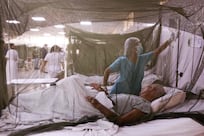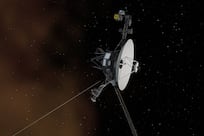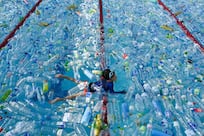In a car park on the east side of Beirut, a vehicle finds shade beneath a strange blue structure made of scaffolding poles and wooden planks. Above its roof, plants sway gently in the breeze. Urban Hives is an installation by local designer Nathalie Harb, who is addressing the lack of green space in the Lebanese capital with an innovative design capable of transforming car parks into community gardens – without reducing parking spaces.
Harb envisages that her modular raised gardens – which can cover a single car or an entire car park – could serve as community allotments, allowing local families to grow and exchange fruit and vegetables, as well as cultivate flowers and other ornamental plants.
In many ways, Urban Hives encapsulates the spirit and themes of the eighth edition of Beirut Design Week. By addressing a local shortcoming – lack of green spaces in the city – Harb's design contributes towards solving a larger global problem: the decimation of the bees that are essential to our survival.

Her design is versatile and cost-effective, tailored to the specific needs of Beirut, where empty lots awaiting construction are often used as temporary car parks, and designed to benefit local communities.
Harb is one of many designers this year whose ideas address pressing sociocultural and political issues – such as the environmental crisis, the impact of technology on our lives, how to improve urban living and the importance of public spaces.
Coming up with a theme
Entitled Design and the City, the annual non-profit event challenges standard interpretations of what designers do and who their work is for, focusing not on commercial product design, but on conceptual projects exploring the role of design in an urban context.
Doreen Toutikian, director of Beirut Design Week, says that the urban theme was the result of collective interest in socially conscious design in the wake of the recent Lebanese parliamentary elections.
"We found that a lot of people wanted to be more active citizens within their urban environment," she says. "They were demanding a lot of things that they weren't really getting, and a lot of young creatives like architects and designers have been very active within these young political movements… We thought that Beirut Design Week would be a very good time and place for all of these initiatives to come together to really create awareness about what could be done in the city," Toutikian adds.

The director and her team have tried to make the programme as broad as possible, focusing on a different area of the city each day, collaborating with a wide variety of partners and venues and trying to attract audiences that don't habitually engage with the design community or visit museums and gallery spaces. Exhibitions running throughout the week are supplemented by a daily programme of workshops, round tables, open studios, urban interventions and pop-up exhibitions.
“We really have to face facts: designers have for a very long time been living in a mental state that everything is about luxury and making things that most people can’t actually afford, and this is problematic,” says Toutikian. “From the beginning, we really tried to balance the luxury product part with the social-environmental part, so that the designers that are just focused on luxury see the relevance of design for social impact.” Harb’s installation is one of three located in a car park where a flower market attracts a diverse set of visitors each day during the summer months and children come to play in the evenings.
The installations
Pop-up Waterscape is a temporary water feature in which visitors are invited to play and paddle, or just sit and dip their feet. Designed by Greek landscape architect and designer Andreas Nassos in collaboration with Toutikian, it is intended to draw attention to Beirut's lack of spaces for urban play, build community ties and highlight issues surrounding access to water.
A third installation, Shame on Us, takes visitors in a darker direction, requiring them to enter a small hut alone and place their heads and hands into a wooden reproduction of a Medieval pillory. For four minutes, they are subjected to an onslaught of oral and visual horror, in which images of leaves unfurling and animals in nature give way to torturous footage of the human impact on earth in the industrial age. Factories spew black smoke into the sky. Animals are killed and hacked for meat. Soldiers march and children starve.
Bombarded with a cacophonic soundtrack, sweating in the heat, visitors are ultimately presented with a live video feed of themselves, forced to confront their own role in mankind’s destruction of the planet. Uncomfortable as it is to experience, the installation is powerful and effective, well worth suffering through. Many visitors are shaken when they leave the small space and the duo behind the project, Dominique Chouchani (known as Das Scharf) and Fouad Bechwati (21dB), have prepared a recovery area, a small circle of swings surrounded by greenery where visitors can listen to soothing audio files as they recover.
“It’s seriously a global pandemic that we build and build and consume and breed,” says Bechwati. “We are seven billion. There is no going back. We know that. We’re not giving solutions… We’re just stating a fact, that we are on top of the food chain, but with that comes a great deal of responsibility towards the planet that we live on, which we completely ignore … We are the only species that lives in complete disharmony with nature,” he says.
Bechwati’s installation is all about confronting the problems of the present, but over at Beit Beirut, the museum housing the three week-long exhibitions that form the heart of this year’s programme, designers are thinking about the problems – and solutions – of the future.
The exhibition Mind the Map, a collaboration with Public Works Studio, focuses on assessing the existing urban fabric and infrastructure of the city – how to map it, what works well, what is dysfunctional or missing.
It includes fascinating maps of the city based on interviews with 23 Syrian delivery men, who identify the landmarks they use to navigate. Other projects chart the history of the polluted Beirut River, use a balloon and a digital camera to map the Bourj al Shamali Palestinian refugee camp, with a view to creating a public garden, and explore how urban planning exacerbates inequality.
_____________________
Read more:
Beirut exhibition presents a picture of Syria's suffering
Vision of another Lebanon presented at the Venice Architecture Biennale
Nadine Labaki on her historic Cannes win
_____________________
This exhibition sets the scene for Design Does Beirut*. For Better and For Worse, a set of speculative projects that explore what design can and more importantly should do, raising ethical questions, encouraging audience participation and eliciting perspectives, and proposing ways in which design can be harnessed to improve the urban environment.
Visitors are asked to fill out surveys about creativity and to leave thumbprints marking their responses to a series of questions about their relationships to the design objects that shape the contemporary world, from smart phones, to flags, to social media platforms.
An installation by local designer Tatiana Toutikian, Curious Extrapolations, takes this interactivity a step further, inviting visitors on a journey to the future via four audio tracks describing imagined scenarios of playing, praying, sharing and dying in the city.
In one, a craze for sharing information about health and fitness leads to multimedia digital tombstones that monitor decomposition and soil quality after death. In another, pets and plants are equipped with cameras and Instagram accounts and begin posting regular selfies. Visitors must decide whether each scenario is utopic or dystopic.
A final exhibition, Independent Beirut, takes the most traditional approach towards design, showcasing new products produced by local designers and inspired by the urban environment, from candle holders based on graffiti, to furniture echoing Islamic architecture and ceramics inspired by pedestrian infrastructure – or the lack of it.

Challenging, innovative and unusual, this edition of Beirut Design Week succeeds in conveying the extent to which design shapes every aspect of life in an urban context. Visitors come away with a clearer understanding of the challenges we face, both on a local and a global level, and a sense that they cannot be solved by the design community alone. Many of the projects on show this year depend on public interaction and engagement to function. So does the city.
Beirut Design Week continues until June 29





